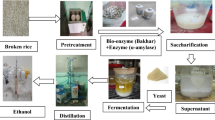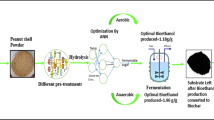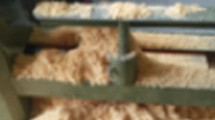Abstract
The enzymatic and bio-enzymatic saccharification of waste broken rice (79.8% of starch) was successfully carried out to produce a reducible sugar solution (160 g/L). Bioethanol of concentration 71.2 g/L (9.0% v/v) was prepared by fermentation of reducing sugar solution, using the commercially available waste brewer’s yeast (Saccharomyces cerevisiae). The fermentation process parameters were optimized through response surface methodology (RSM) and hybrid artificial neural network-genetic algorithm (ANN-GA) for optimizing the ethanol concentration. The hybrid ANN-GA model predicted a maximum concentration of 71.9 g/L with a deviation of only 0.97% from the experimental value (71.2 g/L). Four different kinetic models were attempted to fit the experimental time evolution of concentrations with the kinetic parameters estimated by the Levenberg–Marquardt optimization technique. The 4th order Runge–Kutta algorithm was implemented through a C program module. The accuracy of each model was checked against coefficient of determination R2, adjusted R2, the absolute mean deviation (AMD), and root mean square deviation (RMSD). The Andrew-Levenspiel kinetics produced the best performance criteria at two initial substrate concentrations of 160 and 170 g/L. Finally, the FTIR analysis of 781.2 g/L (98.5% v/v) bioethanol (concentrated by two-stage vacuum distillation followed by treatment with 3A molecular sieve) showed a favorable blending possibility with the commercial gasoline (petrol) as a green fuel.








Similar content being viewed by others
Data Availability
Not applicable.
References
Veloso, I. I. K., Rodrigues, K. C. S., Sonego, J. L. S., Cruz, A. J. G., & Badino, A. (2019). Fed-batch ethanol fermentation at low temperature as a way to obtain highly concentrated alcoholic wines : Modeling and optimization. Biochemical Engineering Journal, 141, 60–70.
Halder, P., Azad, K., Shah, S., Sarker, E. (2019). 8- Prospects and technological advancement of cellulosic bioethanol eco fuel production. Advance in Eco fuels for a sustainable Environment, 211–236.
Owusu, P. A., & Asumadu-Sarkodie, S. (2016). A review of renewable energy sources, sustainability issues and climate change mitigation. Cogent Engineering, 3, 1167990.
Aditiya, H. B., Mahlia, T. M. I., Chong, W. T., Nur, H., & Sebayang, A. H. (2016). Second-generation bioethanol production: A critical review. Renewable and Sustainable Energy Reviews, 66, 631–653.
Balat, M., & Balat, H. (2009). Recent trends in global production and utilization of bio-ethanol fuel. Applied Energy, 86, 2273–2282.
Jahnavi, G., Prashanthi, G. S., Sravanthi, K., & Rao, L. V. (2018). Status of availability of lignocellulosic feedstocks in India : Biotechnological strategies involved in the production of Bioethanol Status of availability of lignocellulosic feedstocks in India : Biotechnological strategies involved in the production of bioethanol. Renewable and Sustainable Energy Reviews, 73, 798–820.
Tesfaw, A., & Assefa, F. (2014). Current trends in bioethanol production by Saccharomyces cerevisiae: Substrate, inhibitor reduction, growth variables, Coculture, and immobilization. Hindawi Publishing Corporation, 11, 532852.
Renewable Fuels Association. (2016). Industry statistics - world fuel ethanol production. http://ethanolrfa.org/resources/industry/statistics/#1454098996479-8715d404-e546. Accessed 13 Mar 2018.
Sulieman, A. K., Dharma, M., Abasaeed, A. E., Gaily, M. H., Al-zahrani, S. M., & Zeinelabdeen, M. A. (2018). Kinetic modeling of the simultaneous production of ethanol and fructose by Saccharomyces cerevisiae. Electronic Journal of Biotechnology, 34, 1–8.
Achinas, S., & Euverink, G. J. W. (2016). Consolidated briefing of biochemical ethanol production from lignocellulosic biomass. Electronic Journal of Biotechnology, 23, 44–53.
Luque, L., Oudenhoven, S., Westerhof, R., Rossum, G. V., Berruti, F., Kersten, S., & Lars, R. (2016). Comparison of ethanol production from corn cobs and switchgrass following a pyrolysis-based biorefinery approach. Biotechnology for Biofuels, 9, 242.
Aboagye, D., Banadda, N., Kambugu, R., Seay, J., Kiggundu, N., Zziwa, A., & Kabenge, I. (2017). Glucose recovery from different corn stover fractions using dilute acid and alkaline pretreatment techniques. Journal of Ecology and Environment, 41, 26.
Childs, N., & Skorbiansky, S. R. (2018). Rice outlook, RCS-18D, April 12, 2018 USDA, Economic Research Service. https://www.ers.usda.gov/webdocs/outlooks/88422/rcs-18d.pdf?v=520.3
Xu, E., Wu, Z., Chena, J., Tian, J., Cheng, H., Li, D., Jiao, A., Ye, X., Liu, D., & Jin, Z. (2020). Calcium—lactate-induced enzymatic hydrolysis of extruded broken rice starch to 2 improve Chinese rice wine fermentation and antioxidant capacity. LWT, 118, 10883.
Mondal, P., Sadhukhan, A., Ganguly, A., Gupta, P. (2021). Optimization of process parameters for bio-enzymatic and enzymatic saccharification of waste broken rice for ethanol production using response surface methodology and artificial neural network – genetic algorithm. 3 Biotech 11, 28.
Yang, S-T., Liu, X., Zhang, Y. (2007). Chapter 4 - Metabolic Engineering – Applications, Methods, and Challenges. Bioprocessing for Value-Added Products from Renewable Resources 73–118.
Rajendra, L., Devi, M. C., & Farnandez, C. M. (2018). Mathematical modeling and simulation of nonlinear process in enzyme kinetics. In M. A. Farrukh (Ed.), Advance chemical kinetics. Intechopen 2018. https://doi.org/10.5772/intechopen.70914
Desai, K. M., Survase, S. A., Saudagar, P. S., Lele, S. S., & Singhal, R. S. (2008). Comparison of artificial neural network (ANN) and response surface methodology (RSM) in fermentation media optimization : Case study of fermentative production of scleroglucan. Biochemical Engineering Journal, 41, 266–273.
Feng, T., Zhao, J., Chu, J., Wang, Y.-H., & Zhuang, Y.-P. (2021). Statistical Optimizing of Medium for Clavulanic Acid Production by Streptomyces clavuligerus Using Response Surface Methodology. Applied Biochemistry and Biotechnology. https://doi.org/10.1007/s12010-021-03627-4
Das, S., Bhattacharya, A., Haldar, S., Ganguly, A., Gu, S., & Ting, Y. P. (2015). Optimization of enzymatic saccharification of water hyacinth biomass for bio-ethanol: Comparison between artificial neural network and response surface methodology. Sustainable Materials and Technologies, 3, 17–28.
Malik, K., Salama, E., Hyun, T., & Li, X. (2020). Enhanced ethanol production by Saccharomyces cerevisiae fermentation post acidic and alkali chemical pretreatments of cotton stalk lignocellulose. International Biodeterioration and Biodegradation, 147, 104869.
Al-asheh, S., Banat, F., & Al-lagtah, N. (2004). Separation of Ethanol-Water Mixtures Using Molecular Sieves and Biobased Adsorbents. Chemical Engineering Research and Design, 82(A7), 855–864.
Kumar, R., Ghosh, A. K., & Pal, P. (2017). Fermentative energy conversion: Renewable carbon source to biofuels (ethanol) using Saccharomyces cerevisiae and downstream purification through solar-driven membrane distillation and nanofiltration. Energy Conversion and Management, 150, 545–557.
Lee, S. S., Robinson, F. M., & Wang, H. Y. (1981). Rapid determination of yeast viability. Biotechnology and Bioengineering Symposium, 11, 641–649.
National Center for Biotechnology Education. (2018). University of Reading, 2018. https://www.ncbe.reading.ac.uk/wp-content/uploads/sites/16/2021/10/DNSAinstructions.pdf
Ghanavati, S., Semnani, A., Teimouri, A., Javaheran, M., Momeni, T., & Habibollahi, S. (2019). International Journal of Biological Macromolecules Decolorization of crystal violet from aqueous solutions by a novel adsorbent chitosan/nano-diopside using response surface methodology and artificial neural network-genetic algorithm. International Journal of Biological Macromolecules, 124, 429–443.
Conklin, A., Goldcamp, M. J., Barrett, J. (2014). Determination of Ethanol in Gasoline by FT-IR Spectroscopy. Journal of chemical education, 889–891.
Drapcho, C. M., Nhuan, N. P., & Walker, T. H. (2008). Biofuels Engineering Process Technology. The McGraw-Hill Companies Inc.
Doran, P. M. (1997). Bioprocess Engineering Principles. ACADEMIC PRESS LIMITED.
Lee, J. M. (2008). Biochemical Engineering. Albright’s Chemical Engineering Handbook. Florida: Taylor & Francis Group, LLC. Retrieved from http://www.engnetbase.com/ejournals/categories/-default.asp.
Kong, J. D. (2017). Modeling Microbial Dynamics: Effects on Environmental and Human Health. University of Alberta, Canada. https://doi.org/10.7939/R3FT8DZ73
Dutta, K., Venkata, D., Mahanty, V., & B, Anand Prabhu, A. (2015). Substrate inhibition growth kinetics for Cutinase producing Pseudomonas cepacia using tomato-peel extracted cutin. Chemical and Biochemical Engineering Quarterly, 29(3), 437–445.
Shukor, M.Y. (2014). Mathematical modelling of the growth kinetics of Bacillus sp. on tannery effluent containing chromate. Journal Environment Bioremediation. Toxicological 2 (1). https://journal.hibiscuspublisher.com/index.php/JEBAT/article/view/139.
Dey, S., & Mukherjee, S. (2010). Performance and kinetic evaluation of phenol biodegradation by mixed microbial culture in a batch reactor. Int. J. Water Resour. Environ. Eng, 2, 40–49.
Han, K., & Levenspiel, O. (1988). Extended Monod kinetics for substrate, product, and cell inhibition. Biotechnology and Bioengineering, 32(4), 430–447.
Lahiri, D., Nag, M., Sarkar, T., Dutta, B., & Ray, R. R. (2021). Antibiofilm Activity of α-Amylase from Bacillus subtilis and Prediction of the Optimized Conditions for Biofilm Removal by Response Surface Methodology (RSM) and Artificial Neural Network (ANN). Applied Biochemistry and biotechnology, 193, 1853–1872.
Belwal, T., Dhyani, P., Bhatt, I. D., Singh, R., & Pande, V. (2016). Optimization extraction conditions for improving phenolic content and antioxidant activity in Berberis Asiatica fruits using response surface methodology (RSM). Food Chemistry, 207, 115–124.
Li, H., Wei, B., Wu, C., Zhang, B., Xu, X., & Jin, Z. (2014). Modelling and optimisation of enzymatic extrusion pretreatment of broken rice for rice wine manufacture. Food Chemistry, 150, 94–98.
Helle, S. S., Duff, S. J. B., Coopes, D. G. (1993). Effect of surfactants on Cellulose Hydrolysis Helle 1993 COPY 42.
Sluiter, A., Hames, B., Ruiz, R., Scarlata, C., Sluiter, J., Templeton, D. (2012). Determination of structural carbohydrates and lignin. Laboratory Analytical Procedure (LAP), Technical Report NREL/TP-510–42618.
Corsetti, S., Zehentbauer, F. M., Mcgloin, D., & Kiefer, J. (2015). Characterization of gasoline/ethanol blends by infrared and excess infrared spectroscopy. Fuel, 141, 136–142.
Halder, G., Dhawane, S. H., Dutta, D., Dey, S., Banerjee, S., Mukherjee, S., & Mondal, M. (2016). Computational simulation and statistical analysis of bioethanol production from Madhuca indica by batch fermentation process using Saccharomyces cerevisiae. Sustainable Energy Technologies and Assessments, 18, 16–33.
Sadhukhan, A. K., Gupta, P., & Saha, R. (2008). Modelling and experimental studies on pyrolysis of biomass particles. Journal of Analytical and Applied Pyrolysis, 81, 183–192.
Knowles, G., Downing, A. L., & Barrett, M. J. (1965). Determination of kinetic constants for nitrifying bacteria in mixed culture, with the aid of an electronic computer. Journal of General Microbiology, 38, 263–278.
Westermann, P., Ahring, B. K., Mah, R. A. & Angeles, L. (1989). Temperature compensation in Methanosarcina barkeri by modulation of hydrogen and acetate affinity. Applied and Environmental Microbiology, 55(5), 1262–1266.
Deed, R. C., Deed, N. K., & Gardner, R. C. (2015). Transcriptional response of Saccharomyces cerevisiae to low temperature during wine fermentation. Antonie van Leeuwenhoek, 107, 1029–1048.
Acknowledgements
The authors sincerely acknowledge the computational and analytical instrumentation support received from DST-FIST, GOI by the Department of Chemical Engineering, National Institute of Technology Durgapur, India. The experimental infrastructure support was received from the North-East Technical Development Group of CSIR-CMERI, Durgapur, India.
Author information
Authors and Affiliations
Contributions
Payel Mondal—investigator and performed the experiments, optimization and modeling, and paper writing.
Anup kumar Sadhukhan—conceptualization, supervision, and writing.
Amit Ganguly—supervision while carrying out the experiments.
Parthapratim Gupta—reviewing and editing the paper thoroughly.
Corresponding author
Ethics declarations
Ethics Approval
Not applicable.
Consent to Participate
Not applicable.
Consent for Publication
Not applicable.
Conflict of Interest
The authors declare no competing interests.
Additional information
Publisher's Note
Springer Nature remains neutral with regard to jurisdictional claims in published maps and institutional affiliations.
Rights and permissions
About this article
Cite this article
Mondal, P., Sadhukhan, A.K., Ganguly, A. et al. Production of Blending Quality Bioethanol from Broken Rice: Optimization of Process Parameters and Kinetic Modeling. Appl Biochem Biotechnol 194, 5474–5505 (2022). https://doi.org/10.1007/s12010-022-03858-z
Received:
Accepted:
Published:
Issue Date:
DOI: https://doi.org/10.1007/s12010-022-03858-z




